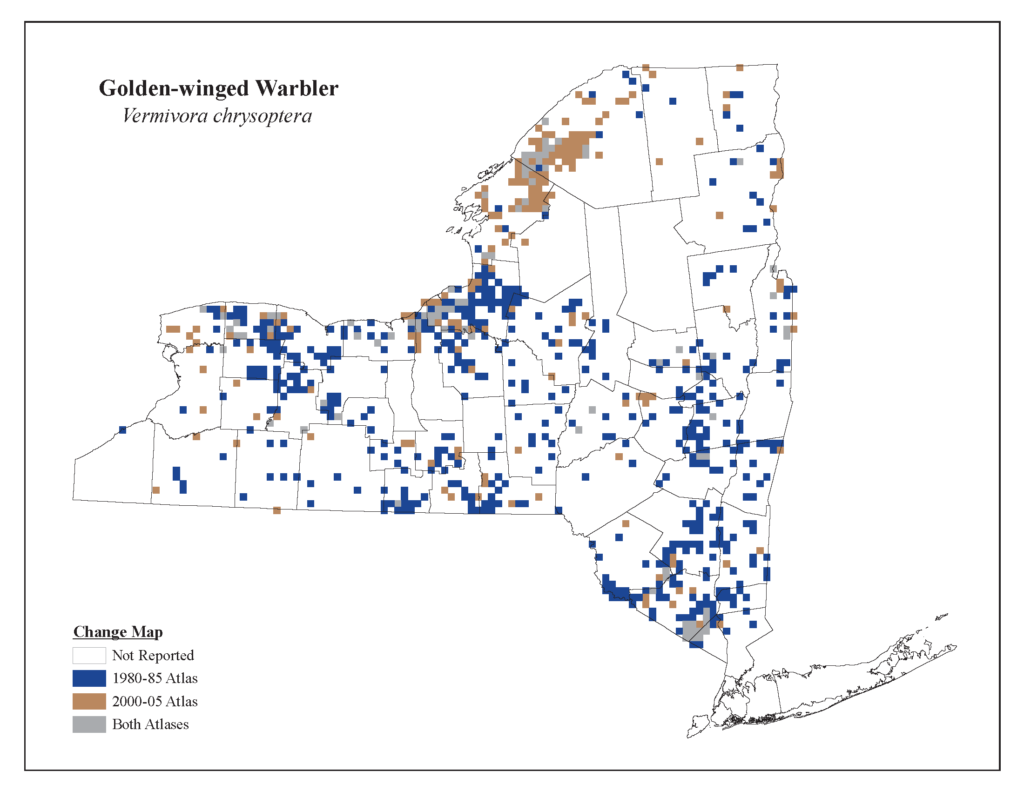A Breeding Bird Atlas occurs every 20 years in NY. The first took place from 1980 to 1985, the second from 2000 to 2005. The third atlas will continue to improve our understanding of changes in the distribution of breeding birds in the state and provide the basis for more informed conservation and management of birds and their habitats. Read below for information that was gathered in the previous atlases as well as scientific journal articles that looked at changes between the two atlases.
Quick Links
Atlas 1: 1980-1985

Change in the distribution of Red-bellied Woodpecker between the first and second atlas. Note the large expansion of the species up the Hudson and Mohawk River valleys, across the southern tier, and into the Buffalo-Niagara region.
In the first atlas, over 4,300 volunteers submitted more than 361,595 observations of 242 species and three hybrids. This was the first time a detailed distribution map was available for some species, while it confirmed our understanding for others.
Ten species known to have previously bred in the state were not confirmed in the first atlas:
- Lesser Scaup
- Golden Eagle
- Black Rail
- King Rail
- Monk Parakeet
- Bewick’s Wren
- Cape May Warbler
- Wilson’s Warbler
- Western Meadowlark
- Dickcissel
Five new breeders were documented:
- Forster’s Tern
- Yellow-throated Warbler
- Palm Warbler
- Blue Grosbeak
- Boat-tailed Grackle
Citation: Andrle, R.F, and J.R. Carroll, eds. 1988. The Atlas of Breeding Birds in New York State. Cornell University Press. (Buteo Books – $35)
Atlas 2: 2000-2005

Change in the distribution of Golden-winged Warbler between the first and second atlas. The species disappeared from much of the state.
1400 volunteers participated in the second atlas and submitted over half a million (519,562) records. These intrepid volunteers documented 248 breeding species and 3 hybrids. Since this was the second atlas in the state, we could look at the change in distribution of each species over the 20 year interval. About one quarter (28%) of species showed range expansion, and one quarter (23%) reduced their range. We also lost a couple of rare breeders (Canvasback and Loggerhead Shrike), but we gained 6 more.
New species recorded in the second atlas were:
- Trumpeter Swan
- Common Eider
- Black Vulture
- Merlin
- Sandhill Crane
- Wilson’s Phalarope
Explore more distribution and change maps from the second atlas on the DEC website.
Citation: McGowan, K. J., and K. Corwin, eds. 2008. The Second Atlas of Breeding Birds in New York State. Cornell University Press. (Buteo Books – $70)
Atlas 3: 2020-2024
Check out the Explore tab to see real-time results from the third atlas. Search by species, block, or region.
Peer-reviewed Publications Based on NY Atlas Data
Ankori-Karlinsky, R, M alyuzhny, KF Barnes, AM Wilson, C Flather, R Renfrew, J Walsh, E Guk & R Kadmon (2022) North American Breeding Bird Survey underestimates regional bird richness compared to breeding bird atlases. Ecosphere, 13:2, e3925. https://doi.org/10.1002/ecs2.3925
Jarzyna, MA, B Zuckerberg, AO Finley & WF Porter (2016) Synergistic effects of climate and land cover: grassland birds are more vulnerable to climate change. Landscape Ecology, 31, 2275-2290. [PDF]
Jarzyna, MA, B Zuckerberg, WF Porter, AO Finley & BA Maurer (2015) Spatial scaling of temporal changes in avian communities: Scale dependence of community turnover. Global Ecology and Biogeography, 24, 1236-1248. [PDF]
Jarzyna, MA, WF Porter, BA Maurer, B Zuckerberg & AO Finley (2015) Landscape fragmentation affects responses of avian communities to climate change. Global Change Biology, 21, 2942-2953. [PDF]
Sadoti, G, B Zuckerberg, MA Jarzyna, and WF Porter (2013) Applying occupancy estimation and modelling to the analysis of atlas data. Diversity and Distributions, 19(7), 804-814. [Full Text]
Zuckerberg, B & WF Porter (2010) Thresholds in the long-term responses of breeding birds to forest cover and fragmentation. Biological Conservation, 143, 952-962. [PDF]
Zuckerberg, B, AM Woods & WF Porter (2009) Poleward shifts in breeding bird distributions in New York State. Global Change Biology, 15, 1866-1883. [Abstract]
Zuckerberg, B, WF Porter & K Corwin (2009) The consistency and stability of abundance–occupancy relationships in large-scale population dynamics. Journal of Animal Ecology, 78, 172-181. [PDF]


